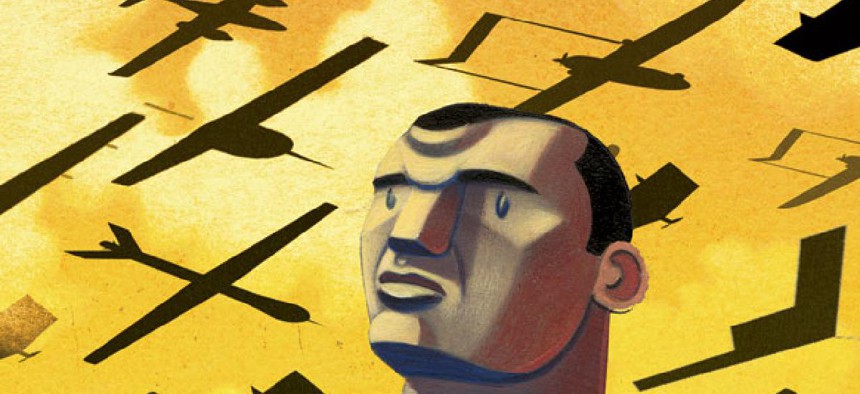
Jon Krause
More Robots On the Fly
Before drones take off, we might want to think about our future.
When you see an airplane zipping through the sky, or notice a traffic helicopter hovering over the freeway, you probably don’t ask yourself, “Is there a person flying that thing?” Give it a few years. Soon you’ll be wondering whether those aircraft are actually flown by human beings in a cockpit, or piloted by some remote controller at a computer terminal miles away.
Under a law that President Obama signed in February, the Federal Aviation Administration must begin plans for incorporating unmanned aerial vehicles, better known as drones, into national airspace. The hard deadline is September 2015, but as soon as this year, some groups, such as emergency responders, could start flying drones.
Until now, military and national intelligence agencies have had the most experience with remotely piloted aircraft, primarily on overseas missions. But as domestic airspace opens up, many more civilian agencies will find unmanned aircraft are ideally suited for their missions as well.
The Agriculture Department probably will turn to drones to monitor crops and livestock. The Forest Service might use the planes for spotting fires and relaying their location to ground crews. The Homeland Security Department already is testing drones for border surveillance. It’s a lot cheaper to put a fleet of robot airplanes over the border with Mexico than to deploy human patrols on the ground. It’s also a lot safer.
An FAA official recently told me there are so many models of drones—and more are expected in the future—that the field “almost defies categorization.” Some take off and land like a typical airplane. Others are launched by hand. Some land by dropping to the ground. A few are caught in nets. FAA’s challenge to license and regulate all those different vehicles may seem overwhelming, but consider what’s at stake. Not only do drones promise efficiencies and cost-savings for federal agencies, but the opening of U.S. airspace will create
a whole new market of commercial drones. The FAA official said it wasn’t unrealistic to imagine FedEx or UPS replacing some of their piloted cargo planes with drones in the near future.
But as soon as these planes take to the skies, court challenges almost certainly will follow. Federal law enforcement agencies will have to pay particular attention here. For instance, wide-area surveillance from high-altitude craft offers an extraordinary capability to monitor people. But is it legal? A recent U.S. Supreme Court decision that police must obtain a warrant to place a GPS tracking device on a suspect’s car might not apply to drones watching people as they walk down the street. The law isn’t settled on this question.
And beyond the legal quandaries, there are moral and ethical considerations as well. In the years to come, drones will have to become more autonomous to meet humans’ expectations. A pilot can control only so many drones at a time, and the more missions these craft are called on to perform, the more they’ll have to operate on their own. Are we really prepared to have planes overhead that are increasingly beyond our control?
Rather than answer these profound questions, legislators and policymakers
have opted first to get the drones in the air. There’s an understandable urge to take advantage of everything that unmanned technology has to offer. But people would do well to consider how the drones could change our world while they are still on the ground.
Shane Harris, a former staff writer at Government Executive, is the author of The Watchers: The Rise of America’s Surveillance State.
NEXT STORY: Imperfect Harmony






